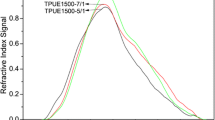Abstract
A simple non-isocyanate route synthesizing thermoplastic polyurethanes (TPUs) with good thermal and mechanical properties is described. Melt transurethane polycondensation of dimethyl 1,6-hexamethylene dicarbamate with 1,4-butanediol and 1,6-hexanediol was conducted at different molar ratios under the catalysis of tetrabutyl titanate. A series of crystallizable non-isocyanate TPUs with high molecular weight were prepared. The TPUs were characterized by gel permeation chromatography, FT-IR, 1H-NMR, differential scanning calorimetry, thermogravimetric analysis, wide angle X-ray diffraction, AFM, and tensile tests. The TPUs exhibited Mn ranging from 12 500 to 26 400 g/mol, Mw from 16 700 to 56 400 g/mol, Tm up to 151.4 °C, and initial decomposition temperature over 241.8 °C. Their tensile strength reached 42.99 MPa with a strain at break of 30.00%. TPUs constructed simply with butylene, hexylene, and urethane linkages were successfully synthesized through a non-isocyanate route.
Similar content being viewed by others
References
Delebecq E, Pascault J P, Boutevin B, et al. On the Versatility of Urethane/urea Bonds: Reversibility, Blocked Isocyanate, and Non-isocyanate Polyurethane[J]. Chem. Rev., 2013, 113: 80–118
Guan J, Song Y H, Lin Y, et al. Progress in Study of Non-isocyanate Polyurethane[J]. .Ind. Eng. Chem. Res., 2011, 50: 6517–6527
Ochiai B, Endo T. Carbon Dioxide and Carbon Disulfide as Resources for Functional Polymers[J]. Prog. Polym. Sci., 2005, 30: 183–215
Kathalewar M S, Joshi P B, Sabnis A S, et al. Non-isocyanate Polyurethanes: from Chemistry to Applications[J]. RSC Adv., 2013, 3: 4110–4129
Tamami B, Sohn S, Wilkes G L. Incorporation of Carbon Dioxide into Soybean Oil and Subsequent Preparation and Studies of Nonisocyanate Polyurethane Networks[J]. J. Appl. Polym. Sci., 2004, 92: 883–891
Brocas A L, Cendejas G, Deffieux A, et al. Controlled Synthesis of Polyepichlorohydrin with Pendant Cyclic Carbonate Functions for Isocyanate-free Polyurethane Networks[J]. J. Polym. Sci., Part A: Polym. Chem., 2011, 49: 2677–2684
Diakoumakos C D, Kotzev D L. Non-isocyanate-based Polyurethanes Derived upon the Reaction of Amines with Cyclocarbonate Resins[J]. Macromol. Symp., 2004, 216: 37–46
Ochiai B, Inoue S, Endo T. One-pot Non-isocyanate Synthesis of Polyurethanes from Bisepoxide, Carbon Dioxide, and Diamine[J]. J. Polym. Sci., Part A: Polym. Chem., 2005, 43: 6613–6618
Annunziata L, Diallo A K, Fouquay S, et al. α,ω-Di(glycerol carbonate) Telechelic Polyesters and Polyolefins as Precursors to Polyhydroxyurethanes: An Isocyanate-free Approach[J]. Green Chem., 2014, 16: 1947–1956
Bähr M, Bitto A, Mülhaupt R. Cyclic Limonene Dicarbonate as a New Monomer for Non-isocyanate Oligo-and Polyurethanes (NIPU) Based upon Terpenes[J]. Green Chem., 2012, 14: 1447–1454
Bähr M, Mülhaupt R. Linseed and Soybean Oil-based Polyurethanes Prepared via the Non-isocyanate Route and Catalytic Carbon Dioxide Conversion[J]. Green Chem., 2012, 14: 483–489
Besse V, Auvergne R, Carlotti S, et al. Synthesis of Isosorbide Based Polyurethanes: An Isocyanate Free Method[J]. React. Funct. Polym., 2013, 73: 588–594
Maier S, Loontjens T, Scholtens B, et al. Isocyanate-free Route to Caprolactam-blocked Oligomeric Isocyanates via Carbonylbiscaprolactam-( CBC)-mediated End Group Conversion[J]. Macromolecules, 2003, 36: 4727–4734
Maier S, Loontjens T, Scholtens B, et al. Carbonylbiscaprolactam: A Versatile Reagent for Organic Synthesis and Isocyanate-free Urethane Chemistry[J]. Angew. Chem. Int. Ed., 2003, 42: 5094–5097
Zimmermann J, Loontjens T, Scholtens B J R, et al. The Formation of Poly(ester-urea) Networks in the Absence of Isocyanate Monomers[J]. Biomaterials, 2004, 25: 2713–2719
Tang D L, Mulder D, Noordover B A J, et al. Well-defined Biobased Segmented Polyureas Synthesis via a TBD-catalyzed Isocyanate-free Route[J]. Macromol. Rapid Commun., 2011, 32: 1379–1385
Deepa P, Jayakannan M. Solvent-free and Nonisocyanate Melt Transurethane Reaction for Aliphatic Polyurethanes and Mechanistic Aspects[J]. J. Polym. Sci., Part A: Polym. Chem., 2008, 46: 2445–2458
Deepa P, Jayakannan M. Solvent-induced Self-organization Approach for Polymeric Architectures of Micropores, Hexagons and Spheres Based on Polyurethanes Prepared via Novel Melt Transurethane Methodology[J]. J. Polym. Sci., Part A: Polym. Chem., 2007, 45: 2351–2366
Rokicki G, Piotrowska A. A New Route to Polyurethanes from Ethylene Carbonate, Diamines and Diols[J]. Polymer, 2002, 43: 2927–2935
Ochiai B, Utsuno T. Non-isocyanate Synthesis and Application of Telechelic Polyurethanes via Polycondensation of Diurethanes Obtained from Ethylene Carbonate and Diamines[J]. J. Polym. Sci., Part A: Polym. Chem., 2013, 51: 525–533
Sharma B, Ubaghs L, Keul H, et al. Synthesis and Characterization of Alternating Poly(amide urethane)s from e-Caprolactam, Amino Alcohols, and Diphenyl Carbonate[J]. Polymer, 2004, 45: 5427–5440
Sharma B, Ubaghs L, Keul H, et al. Synthesis and Characterization of Alternating Poly(amide urethane)s from e-Caprolactone, Diamines and Diphenyl Carbonate[J]. Polymer, 2005, 46: 1775–1783
Sharma B, Ubaghs L, Keul H, et al. Microstructure and Properties of Poly(amide urethane)s: Comparison of the Reactivity of a-Hydroxy-?-?-phenyl Urethanes and a-Hydroxy-?-?-hydroxyethyl Urethanes[J]. Macromol. Chem. Phys., 2004, 205: 1536–1546
Li C G, Li S Q, Zhao J B, et al. Synthesis and Characterization of Aliphatic Poly(amide urethane)s Having Different Nylon 6 Segments through Non-isocyanate Route[J]. J. Polym. Res., 2014, 21: 498
Li S Q, Zhao J B, Zhang Z Y, et al. Synthesis and Characterization of Aliphatic Segmented Poly(ether amide urethane)s through a Non-isocyanate Route[J]. RSC Adv., 2014, 4: 23720–23729
Deng Y, Li S Q, Zhao J B, et al. Crystallizable and Tough Aliphatic Thermoplastic Poly(ether urethane)s Synthesized through a Non-isocyanate Route[J]. RSC Adv., 2014, 4: 43406–43414
Deng Y, Li S Q, Zhao J B, et al. Aliphatic Thermoplastic Poly(ether urethane)s Having Long PEG Sequences Synthesized through a Non-isocyanate Route[J]. Chin. J. Polym. Sci., 2015, 33: 880–889
Author information
Authors and Affiliations
Corresponding author
Additional information
Funded by the National Natural Science Foundation of China (Nos. 21244006 and 50873013), the Beijing Natural Science Foundation (No. 2182056)
Rights and permissions
About this article
Cite this article
Li, S., Deng, Y., Zhao, J. et al. Synthesis and Properties of Non-isocyanate Crystallizable Aliphatic Thermoplastic Polyurethanes. J. Wuhan Univ. Technol.-Mat. Sci. Edit. 33, 1275–1280 (2018). https://doi.org/10.1007/s11595-018-1963-0
Received:
Accepted:
Published:
Issue Date:
DOI: https://doi.org/10.1007/s11595-018-1963-0




